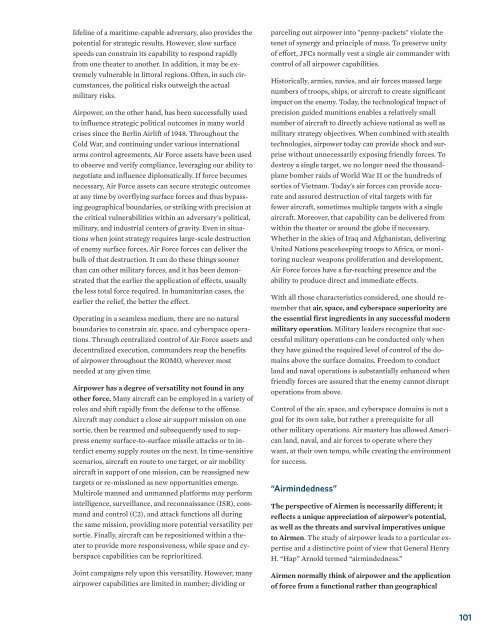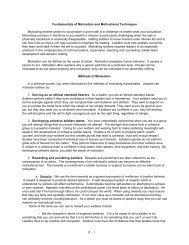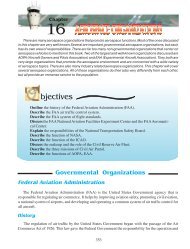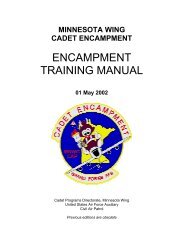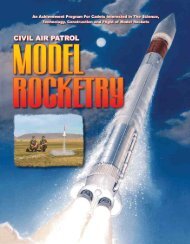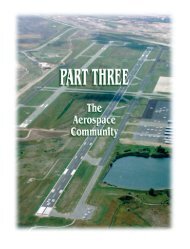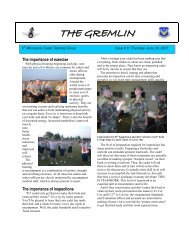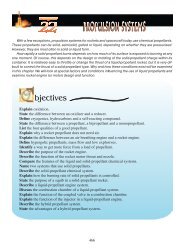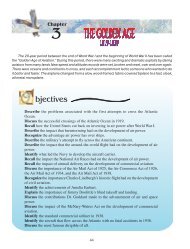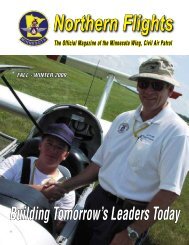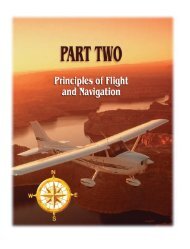earthquake-stricken Haiti. The world at large perceivesAmerican airpower to be a politically acceptable expressionof national power which offers reasonable alternativesto long, bloody ground battles while making animpact on the international situation. While a “boots-onthe-ground”presence may often be required, airpowermakes that presence more effective, in less time, andoften with fewer casualties. Increasingly, US nationalpower and international influence are gauged in terms ofwhat we can or cannot accomplish with this capability.The <strong>Air</strong> Force provides national leadership and jointcommanders with options, the threat of which may accomplishpolitical objectives without the application oflethal force. The means is embedded in the ability to respondrapidly to crises anywhere in the world and acrossthe ROMO. An obvious example is the deterrent roleplayed by the <strong>Air</strong> Force’s nuclear-armed bombers and intercontinentalballistic missiles against the Soviet Unionduring the Cold War. More recently, B-52 and B-2bombers have rotated into Guam to provide a ready andvisible presence.The <strong>Air</strong> Force provides the unique ability to hold atrisk a wide range of an adversary’s options and possiblecourses of action; this is increasingly the key to successfuljoint campaigns. <strong>Air</strong>power is increasingly thefirst military instrument brought to bear against anenemy in order to favorably influence the overall campaign.Frequently, and especially during the opening daysof a crisis, airpower may be the only military instrumentavailable to use against an enemy; this may be especiallytrue if friendly ground forces are not immediately presentin a given region.<strong>Air</strong> Force forces can respond rapidly to apply effects. Thesame spacecraft which <strong>Air</strong>men employ to observe hostileterritory prior to the outbreak of hostilities provide keyintelligence to battle planners. The same aircraft whichprovide visible deterrence to a potential aggressor can beemployed immediately to defend or attack should deterrencefail. The shift from deterrent force to combat poweris near-instantaneous. From ready deterrent to bombson-targetis only a question of command and control andflight time.<strong>Air</strong>power is more than dropping bombs, strafing targets,firing missiles, providing precision navigation andtiming, or protecting networks. It is also a way of influencingworld situations in ways which support nationalobjectives. To most observers in the post-ColdWar world, the use of military power is politically less acceptablethan in previous times. This is true even if we actin a purely humanitarian endeavor or influence a giveninternational political situation with a modest show offorce. In international disasters, natural or man-made,from the Berlin <strong>Air</strong>lift to earthquake relief operations inPakistan, the <strong>Air</strong> Force is the only military force in theworld which has the airlift and air refueling capability toprovide immediate relief supplies and personnel in responseto global emergencies. <strong>Air</strong> Force aircraft deliveringrelief supplies serve not only to alleviate theimmediate situation, but also to provide a visible symbolof the care, concern, and capability of the US. Throughcareful building of partnerships, <strong>Air</strong> Force forces can favorablyshape the strategic environment by assessing, advising,training, and assisting host nation air forces intheir efforts to counter internal or external threats. Theperception of credible US forces underpins many deterrenceand assurance strategies. Such activities lead togreater regional stability and security.Within the broad sweep of history, the benefits of this instrumentof military power are relatively new. Up untilthe latter part of the 20th century, naval forces providedthe primary symbol of American military power and resolve;powerful warships making port calls throughoutthe world were visible symbols of the strength and capabilityof the US. Today, airpower plays a very similarrole—and not just in those nations with major seaports. Innumerous humanitarian operations, <strong>Air</strong>men have providedrelief, demonstrated resolve, and helped to shapethe attitudes of world leaders and their people.This influence is more than just airplanes. US spacebasedassets are a non-intrusive method of providing upto-the-minutewarning and information on the maneuverof hostile military forces or other potentially dangerousactions. The US often shares this information withfriendly nations in response to potential adversaries todefuse points of conflict before they result in hostilities.US air, space, and cyberspace capabilities provide themeans to alert allies of a potential aggressor's hostile intentionsor impending attack when in-country physicalpresence is unwarranted. They can influence potentialadversaries by stripping them of the ability to hide hostilemilitary activity without violating national sovereignty.<strong>Air</strong>power’s speed, range, flexibility, precision, andlethality provide a spectrum of employment optionswith effects that range from tactical to strategic. Thisrange of effects is an important contribution. A surfacecentricstrategy often seeks its outcome through the destructionof hostile land forces and the occupation ofterritory. However, destruction of hostile land forces maybe only a tactical or operational objective and may notachieve the desired strategic outcome. Further, territorialoccupation, with its attendant large cultural footprint,may not be feasible or politically acceptable. Sea power,with its ability to project force and disrupt the economic100
lifeline of a maritime-capable adversary, also provides thepotential for strategic results. However, slow surfacespeeds can constrain its capability to respond rapidlyfrom one theater to another. In addition, it may be extremelyvulnerable in littoral regions. Often, in such circumstances,the political risks outweigh the actualmilitary risks.<strong>Air</strong>power, on the other hand, has been successfully usedto influence strategic political outcomes in many worldcrises since the Berlin <strong>Air</strong>lift of 1948. Throughout theCold War, and continuing under various internationalarms control agreements, <strong>Air</strong> Force assets have been usedto observe and verify compliance, leveraging our ability tonegotiate and influence diplomatically. If force becomesnecessary, <strong>Air</strong> Force assets can secure strategic outcomesat any time by overflying surface forces and thus bypassinggeographical boundaries, or striking with precision atthe critical vulnerabilities within an adversary's political,military, and industrial centers of gravity. Even in situationswhen joint strategy requires large-scale destructionof enemy surface forces, <strong>Air</strong> Force forces can deliver thebulk of that destruction. It can do these things soonerthan can other military forces, and it has been demonstratedthat the earlier the application of effects, usuallythe less total force required. In humanitarian cases, theearlier the relief, the better the effect.Operating in a seamless medium, there are no naturalboundaries to constrain air, space, and cyberspace operations.Through centralized control of <strong>Air</strong> Force assets anddecentralized execution, commanders reap the benefitsof airpower throughout the ROMO, wherever mostneeded at any given time.<strong>Air</strong>power has a degree of versatility not found in anyother force. Many aircraft can be employed in a variety ofroles and shift rapidly from the defense to the offense.<strong>Air</strong>craft may conduct a close air support mission on onesortie, then be rearmed and subsequently used to suppressenemy surface-to-surface missile attacks or to interdictenemy supply routes on the next. In time-sensitivescenarios, aircraft en route to one target, or air mobilityaircraft in support of one mission, can be reassigned newtargets or re-missioned as new opportunities emerge.Multirole manned and unmanned platforms may performintelligence, surveillance, and reconnaissance (ISR), commandand control (C2), and attack functions all duringthe same mission, providing more potential versatility persortie. Finally, aircraft can be repositioned within a theaterto provide more responsiveness, while space and cyberspacecapabilities can be reprioritized.Joint campaigns rely upon this versatility. However, manyairpower capabilities are limited in number; dividing orparceling out airpower into "penny-packets" violate thetenet of synergy and principle of mass. To preserve unityof effort, JFCs normally vest a single air commander withcontrol of all airpower capabilities.Historically, armies, navies, and air forces massed largenumbers of troops, ships, or aircraft to create significantimpact on the enemy. Today, the technological impact ofprecision guided munitions enables a relatively smallnumber of aircraft to directly achieve national as well asmilitary strategy objectives. When combined with stealthtechnologies, airpower today can provide shock and surprisewithout unnecessarily exposing friendly forces. Todestroy a single target, we no longer need the thousandplanebomber raids of World War II or the hundreds ofsorties of Vietnam. Today's air forces can provide accurateand assured destruction of vital targets with farfewer aircraft, sometimes multiple targets with a singleaircraft. Moreover, that capability can be delivered fromwithin the theater or around the globe if necessary.Whether in the skies of Iraq and Afghanistan, deliveringUnited Nations peacekeeping troops to Africa, or monitoringnuclear weapons proliferation and development,<strong>Air</strong> Force forces have a far-reaching presence and theability to produce direct and immediate effects.With all those characteristics considered, one should rememberthat air, space, and cyberspace superiority arethe essential first ingredients in any successful modernmilitary operation. Military leaders recognize that successfulmilitary operations can be conducted only whenthey have gained the required level of control of the domainsabove the surface domains. Freedom to conductland and naval operations is substantially enhanced whenfriendly forces are assured that the enemy cannot disruptoperations from above.Control of the air, space, and cyberspace domains is not agoal for its own sake, but rather a prerequisite for allother military operations. <strong>Air</strong> mastery has allowed Americanland, naval, and air forces to operate where theywant, at their own tempo, while creating the environmentfor success.“<strong>Air</strong>mindedness”The perspective of <strong>Air</strong>men is necessarily different; itreflects a unique appreciation of airpower’s potential,as well as the threats and survival imperatives uniqueto <strong>Air</strong>men. The study of airpower leads to a particular expertiseand a distinctive point of view that General HenryH. “Hap” Arnold termed “airmindedness.”<strong>Air</strong>men normally think of airpower and the applicationof force from a functional rather than geographical101
- Page 1 and 2:
VOLUME FOUR STRATEGIC PERSPECTIVESL
- Page 3 and 4:
VOLUME FOUR STRATEGIC PERSPECTIVESL
- Page 5 and 6:
VOLUME FOUR STRATEGIC PERSPECTIVESL
- Page 7:
VOLUME FOUR STRATEGIC PERSPECTIVESL
- Page 10 and 11:
12CHAPTER 12INTRODUCTION TO STRATEG
- Page 12 and 13:
12.1 Strategic Leadership: Defining
- Page 14 and 15:
mandates or resolutions that would
- Page 16 and 17:
and ambiguity, aspiring strategic l
- Page 18 and 19:
12.2 National Security StrategyThe
- Page 20 and 21:
within our borders has always been
- Page 22 and 23:
front common challenges like violen
- Page 24 and 25:
and our strategy, not sector earmar
- Page 26 and 27:
thinking about organizations. She m
- Page 28 and 29:
A systemic approach to failure is m
- Page 30 and 31:
The late W. T. Grant Company is a r
- Page 32 and 33:
the resources - setting the directi
- Page 34 and 35:
focal point for describing and inte
- Page 36 and 37:
Consequently, we do not restrict th
- Page 38 and 39:
paragraphs, Web pages, then edit an
- Page 40 and 41:
Web, can be viewed as a CS attempt
- Page 42 and 43:
How to evaluate users and contribut
- Page 44 and 45:
13CHAPTER 13LEADING PUBLIC &VOLUNTE
- Page 46 and 47:
13.1 Leadership for Volunteers:The
- Page 48 and 49:
13.2 Take Root: Volunteer Managemen
- Page 50 and 51:
QualificationsClearly list educatio
- Page 52 and 53: and effectively track their volunte
- Page 54 and 55: • Understand rules for recognitio
- Page 56 and 57: • Send a birthday card.• Submit
- Page 58 and 59: and tested more than six decades af
- Page 60 and 61: specific interests of the donors, v
- Page 62 and 63: tain) tax-exempt status from the In
- Page 64 and 65: Smucker, 1999).The Internal Revenue
- Page 66 and 67: culture is necessary to ensure the
- Page 68 and 69: 13.4 The New Look of TransparencyBy
- Page 70 and 71: ees for a couple of reasons: One, i
- Page 72 and 73: 13.5 Public and Private Management:
- Page 74 and 75: TABLE 1:FUNCTIONS OF GENERAL MANAGE
- Page 76 and 77: 3. Career System. The model corpora
- Page 78 and 79: islative charter - the Clean Air Ac
- Page 80 and 81: In controlling performance, Chapin
- Page 82 and 83: 14CHAPTER 14AIRPOWER ASSTRATEGIC LA
- Page 84 and 85: 14.1 Strategic Air Power: Fulfillme
- Page 86 and 87: carry it out. Their daylight raids
- Page 88 and 89: you did not rely on strategic bombi
- Page 90 and 91: 14.2 Warden and the Air Corps Tacti
- Page 92 and 93: ecomes one of applying sufficient i
- Page 94 and 95: tification, and a Jominian claim to
- Page 96 and 97: courage the rapid and widespread ex
- Page 98 and 99: it to influence physical players in
- Page 100 and 101: 14.4 Basic Air Force DoctrineAF Doc
- Page 104 and 105: perspective. Airmen do not divide u
- Page 106 and 107: Command and ControlCommand and cont
- Page 108 and 109: 14.5 Should the US Maintain the Nuc
- Page 110 and 111: form of human government.” 20 Dem
- Page 112 and 113: obtainable goal. See the Global Zer
- Page 114 and 115: 15CHAPTER 15ORGANIZATIONAL CULTURE
- Page 116 and 117: 15.1 Organizational CultureBy Doria
- Page 118 and 119: Review. This action strives to unco
- Page 120 and 121: gram will serve and then having the
- Page 122 and 123: ticipating the changes being made b
- Page 124 and 125: Many years of working with change p
- Page 126 and 127: At the least, the areas of concern
- Page 128 and 129: 15.4 Developing an Innovative Cultu
- Page 130 and 131: CONCLUDING THOUGHTSIn an ever-chang
- Page 132 and 133: global issues. Businesses that poss
- Page 134 and 135: — Sees the big picture—the shif
- Page 136 and 137: 16CHAPTER 16STRATEGIC COMMUNICATION
- Page 138 and 139: 16.1 Principles of Strategic Commun
- Page 140 and 141: 16.2 The Art of NegotiationBy Brend
- Page 142 and 143: 16.3 Negotiating Effectively Across
- Page 144 and 145: hidden areas can act as cultural ho
- Page 146 and 147: and four conflict styles. Hammer be
- Page 148 and 149: maintaining the relationship. As th
- Page 150 and 151: 25 Mitchell R. Hammer, “Chapter 1
- Page 152 and 153:
tural, socioeconomic, and psycholog
- Page 154 and 155:
for the win-win," during which time
- Page 156 and 157:
interests and, at worst, as a gun s
- Page 158 and 159:
Public diplomacy is surely about mu
- Page 160 and 161:
But public diplomats do not have th
- Page 162 and 163:
Photo courtesy of the familyThe LEA
- Page 164:
THE CADET OATHI pledge that I will


